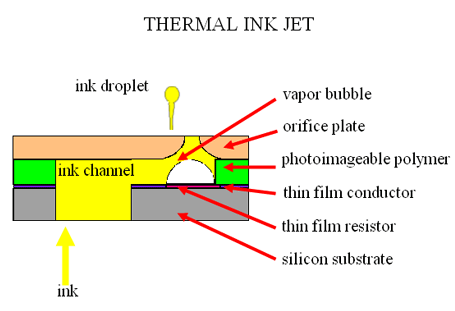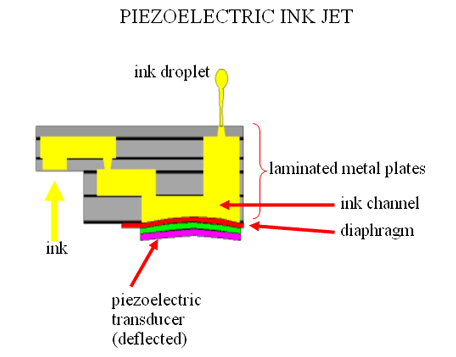How an ink jet printer works
Eric Hanson Hewlett Packard Laboratories
Ink jet printers are the most common type of printing devices used in home environments, and they are also frequently used personal printers in offices. There are two key reasons for the widespread adoption of ink jet printers: low purchase price and very impressive image quality that equals or exceeds that of traditional photographic film.
At the heart of an ink jet printer are a large number of high-precision microscopic nozzles which eject ink onto the paper. These nozzles are typically about 10 micrometers in diameter (roughly 1/10th of the diameter of a human hair). It is not unusual for a home ink jet printer to contain thousands of nozzles in all, several hundred for each color of ink. The diameter of each of these nozzles is fabricated with sub-micrometer accuracy to achieve consistent and uniform ink drop volume, which is essential for consistent and uniform color density on the page. Several different precision micro-fabrication techniques for ink jet nozzles are employed in commercial production, including electroforming, laser ablation, anisotropic etching, and photolithography. For each color of ink, all of the nozzles on the carriage are typically formed in a single fabrication step to precisely control their relative positions, which is important to achieve uniform print without banding. In some cases, all of the nozzles for every color of ink are formed together in a single step. The nozzles are all formed as orifices through a single planar sheet of a material. This material is selected for its compatibility with the particular fabrication method chosen.
The ink jet nozzles are all mounted together on a moving carriage assembly that moves at high velocity (typically > 1 meter per second) back and forth across the paper. The nozzles are mounted about 1 mm from the paper, and ink ejection velocities are in the range of 5 to 10 meters per second.
Ink is ejected from a nozzle by applying a pulse of pressure to the fluid ink in the supply tube, upstream of that nozzle. There are two common methods of creating this pressure pulse: thermal bubble and piezoelectric.
In the thermal bubble technique, ink channels are formed on the surface of a planar substrate using a photoimageable polymer. A small heater is formed using a thin film resistive metallic layer less than 1 micrometer thick in the wall of the ink channel leading to each nozzle. Typically, such a heater is square in shape, about 10 to 20 micrometers on each side. Low resistance thin film metallic conductor connections are attached to two opposing sides of the heater resistor, and a pulse of electrical current is flowed through the heater resistor for about 1 microsecond in duration. The amplitude of this electrical current is designed to heat the resistor enough to boil the ink. A thin layer of ink (about 0.01 micrometer of ink) closest to the resistor explosively boils, forming a vapor bubble and expanding about one thousand times in volume. This volume expansion creates a pressure pulse in the fluid, causing ink in the nozzle (downstream of the heater) to be ejected toward the paper. After several microseconds, the vapor bubble cools and collapses. Then the surface tension of the ink meniscus in the nozzle pulls in more ink from the reservoir to refill the nozzle in preparation for the next drop to be ejected.

|
| Figure 1. |
The second pressure pulse technique uses piezoelectric materials, which are crystalline materials having the property of deforming when high electric fields are applied across them. Two configurations are commonly used: piezoelectric rods which elongate under applied fields, or bimorphs which bend (in a geometry similar to a drum head). In either case, these materials are configured so that they deform one of the walls of the ink channel leading to each nozzle. This deformation squeezes the channel, creating a pressure pulse and ejecting ink from the nozzle. An elastic diaphragm typically isolates the crystalline piezoelectric materials from the ink. The electrical pulses which energize these piezoelectric elements are once again in the microsecond range. The ink channels in a piezoelectric ink jet printhead can be formed using a variety of techniques, but one common method is lamination of a stack of metal plates, each of which includes precision micro-fabricated features of various shapes.

|
| Figure 2. |
The two pressure generation methods have different pros and cons. The heater resistors used in the thermal bubble technique are substantially smaller than piezoelectric elements, which is a plus. Also the heater resistors and their electrical leads can be fabricated directly on a silicon chip which also contains integrated driving electronics and furthermore has the ink channels formed in fluidic layers by photoimageable polymer on its surface, another plus. On the other hand, the thermal bubble technique does boil a thin layer of the ink (approximately 1/1000th of the ink is boiled, vaporizes, re-condenses during operation). Because of the boiling, the ink must be designed to avoid thermal decomposition products which might build up in the ink channels. Piezoelectric ink jets do not boil the ink. However, in practice, ink jet printing inks have been designed which have excellent performance for home and office ink jet printers and suffer no degradation under the boiling experienced in a thermal bubble ink jet printer. So in actuality, ink boiling has not been a minus in the performance of thermal bubble ink jet printing in the home and office, aside from some additional care in the design of ink components.
Inks for all types of ink jet printing are carefully filtered during manufacturing to eliminate any particulates which might clog the narrow channels and nozzles. Additional filters are located in the ink jet printers themselves in the fluid manifolds upstream of the narrow channels. Ink jet printing inks are commonly water-based, and contain either dyes (colored molecules) or pigments (colored crystalline materials). Design of ink jet printing inks is deceptively complex. For example, the ink should dry very rapidly when it lands on the paper, but it should not dry in the nozzle. A number of different additives are typically required in each ink, proper balance, to achieve the right mix of properties for high image quality and robust operation.
When the ink jet printer is not operating, the nozzles are all covered by a large cap which keeps the ink from drying out and potentially clogging the nozzles. However, during operation, depending on the image being printed, some of the individual nozzles may scan repeatedly across the page without needing to print at all, and this could be a problem because the nozzles are all uncapped at that point. To prevent ink from drying in nozzles from such conditions ink is fired from every nozzle at regular intervals, sometimes as often as once each scan across the page. The carriage is designed to scan well past one edge of the paper, where a waste ink receptacle is located, and this is where the extra ink drops are fired. From time to time, the nozzle plate of the ink jet printhead is also wiped with a squeegee blade, somewhat like a windshield wiper, to make sure that it is clear of debris which could deflect the ink jets.
Ink drops are commonly printed at a resolution of 600 or 1200 dots per inch. Typical drop volumes of individual ink drops are in the range of 1 to 5 picoliters, producing printed spot sizes on the paper in the range of 10 to 20 micrometers in diameter. Halftone patterns with varying numbers of dots per unit area are used to produce colors of varying intensity, which are less saturated than pure inks. These halftone patterns are optimized to minimize the visibility of the dot structure to the human eye. Normally black plus the three subtractive primary colors (cyan, magenta, and yellow) are the 4 main colors printed. In addition, for photographic images it is common also print light cyan, light magenta, and perhaps gray (all of which have reduced colorant concentrations compared to the main saturated inks). These light inks allow a significant increase in the smoothness of the lightly colored portions of images, resulting in substantially less image graininess in those areas than if they were printed with only the saturated inks.
Accurate placement of ink dots on the page is critical to achieving uniform colors without banding. Optical encoders precisely control the location of the printed dots, both across and down the page. An optical encoder consists of three main components: a light emitting diode, a photodetector, and a transparent code wheel or code strip positioned between the light emitter and the detector. The motion of the ink jet carriage across the page is controlled by a long plastic code strip which extends across the full width of the print zone. This code strip passes between a light emitter and detector mounted on the moving carriage. To the casual observer, this plastic strip might look like an unimportant light gray piece of flimsy plastic sheet material, but it is actually one of the keys to the precision of the whole ink jet mechanism. It consists of a dense array of precision black stripes printed on a thin sheet of clear plastic, which make it look from a distance like it is a uniform color of light gray. As the carriage passes each stripe, the light beam is interrupted and the photodetector generates a synchronization pulse which controls the timing of the ink drop ejection. These synchronization signals insure that the ink drops are printed in accurate locations even if there is some variation in the carriage velocity, or if the carriage is accelerating or decelerating near the beginning or end of its travel.
The location of the dots up and down the page is controlled by two different factors: nozzle pitch and a second encoder. Nozzle pitch is the spacing between the nozzles on the carriage - as described above, this precision spacing is built into the product by fabricating all of the nozzles for any given color in a single step in a single planar sheet of material. The second factor is the swath advance: the precisely controlled distance of paper advance after each pass of the carriage across the paper. This advance distance is controlled by the second encoder, which uses a disk-shaped code wheel with radial stripes and is mounted on the shaft of the paper advance motor. Using this encoder, accurate swath advance is achieved without high-precision motors or mechanical systems.
Ink jet printers produce excellent quality print on plain uncoated paper, and such papers are commonly used for documents of many different kinds. Photographic images can also be printed on plain paper, but special papers are used when the goal is to achieve the look of a photograph. These photographic papers are thicker than plain paper, and are coated with a very smooth surface. This surface layer is also specially designed to accommodate the fluid in the ink jet ink.